“La Carratera De La Muerte” – The World Most Dangerous Road
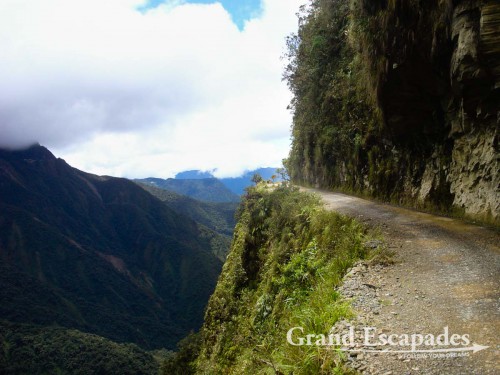
La Carratera de la Muerte or Death Road, going down from 4.650 meter to 1.250 Meter in only 64 Kilometer, between La Paz & Coroico, Bolivia
Most people may have heard of this road which starts in La Paz descending 3.450 meters down into the Yungas, within only 64km. Only until you see it for yourself, does the name “Death Road” sound extreme. It is an unpaved gravel road that was wedged out of the mountain in the 1930s by Paraguayan prisoners of war.
Nobody knows how many died during the construction, but statistics for more recent time are available. Every year about 200 – 300 died on this short stretch. In one year about 25 vehicles fell off the road, making it one every two weeks. In 1985 a completely overcrowded bus plunged down killing everybody and making it Bolivia’s single worst traffic accident. The name “Death Road” is not an invention of sensational journalism but was given to the road in 1995 by the Inter American Development Bank.
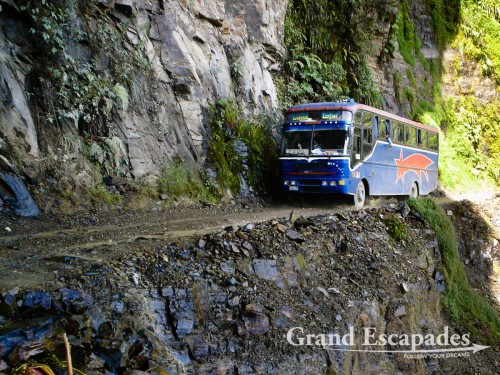
La Carratera de la Muerte or Death Road, going down from 4.650 meter to 1.250 Meter in only 64 Kilometer, between La Paz & Coroico, Bolivia – Cortesy from Downhill Madness
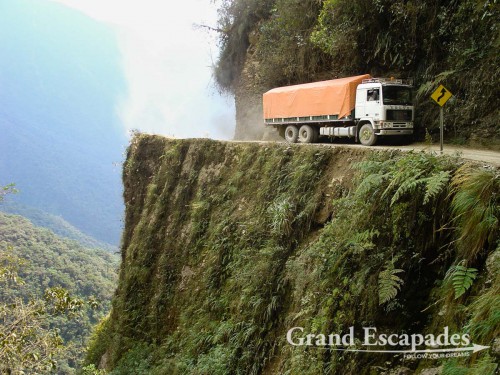
La Carratera de la Muerte or Death Road, going down from 4.650 meter to 1.250 Meter in only 64 Kilometer, between La Paz & Coroico, Bolivia – Cortesy from Downhill Madness
The reasons are many. First of all, at some parts of the, if you want to call it a road, are so narrow that it seems hardly a car can pass, about 3 meters wide. High rock walls go up on one side, whereas on the valley side the cliffs go down hundreds of meters. Irresponsible driving, alcohol and the conditions of the vehicles are others. During the dry season the road is a ribbon of dust with clouds of sand engulfing the vehicles and bringing visibility down to zero. Fog is quite common in this area and during the rainy season cascades of water rush down the mountain turning the surface into a slippery, slimy mass.
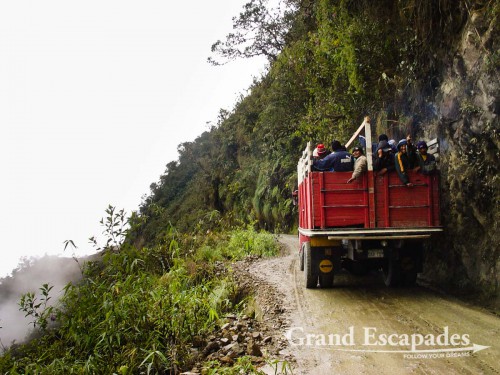
La Carratera de la Muerte or Death Road, going down from 4.650 meter to 1.250 Meter in only 64 Kilometer, between La Paz & Coroico, Bolivia – Cortesy from Downhill Madness
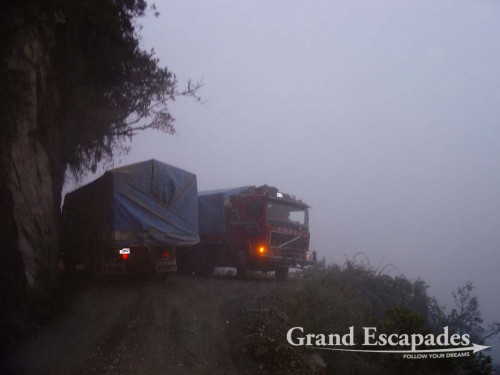
La Carratera de la Muerte or Death Road, going down from 4.650 meter to 1.250 Meter in only 64 Kilometer, between La Paz & Coroico, Bolivia – Cortesy from Downhill Madness
Now this notorious 64 km road was not a path that connects a couple of villages, but was the main and ONLY link from La Paz to the fertile Yungas region with its coffee and coca plantation, and then further into Bolivia’s Amazon Basin and at last into Brazil. It was heavily frequented by trucks, busses and all kinds of vehicles.
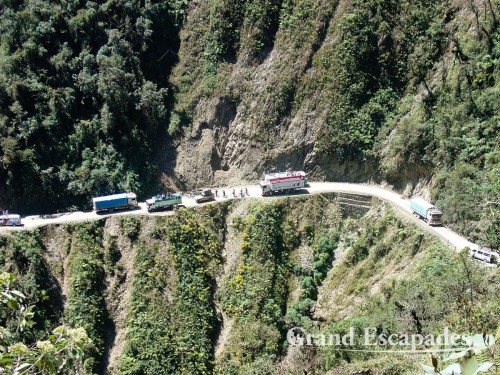
La Carratera de la Muerte or Death Road, going down from 4.650 meter to 1.250 Meter in only 64 Kilometer, between La Paz & Coroico, Bolivia – Cortesy from Downhill Madness
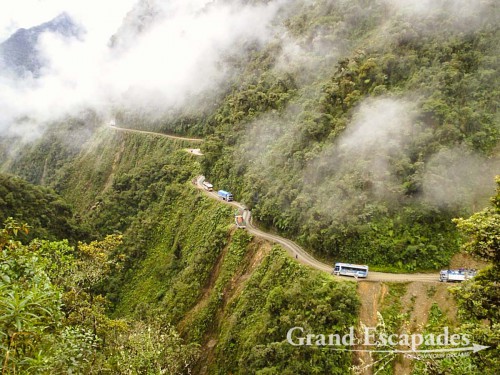
La Carratera de la Muerte or Death Road, going down from 4.650 meter to 1.250 Meter in only 64 Kilometer, between La Paz & Coroico, Bolivia – Cortesy from Downhill Madness
Accidents were so common that special driving rules were introduced for this road: vehicles going up had to drive on the mountain side of the road, forcing trucks going downhill to slow down and allowing their drivers to be able see more accurately how far the outer wheels were from the cliff’s edge, especially when passing each other. Hence, this road was the only one in America where people drove on the left. People from La Paz and Coroico told us how horrifying that trip was and that drivers would have all kind of rituals before starting out hoping for a safe trip, like praying or bringing offerings. The side of the road is full of crosses or plagues remembering those travelers whose prayers went unheard.
Talks about building a new road started 20 years ago, but only in December 2006 was this one opened. So all this is history now, since most cars take the new road and “Death Road” has been given a new purpose – it has become a Mecca of mountain biking in Bolivia, something we could not miss.
This trip down the mountain was one of the most memorable experiences of our trip so far. It was simply fantastic, like a great dinner, you do not want it to end!
About ten years ago a company in La Paz started offering biking down this road in the midst of all the traffic chaos and dust, which added a few more fatal accidents with bikers falling off the cliffs or hitting trucks. There again, the exact number of casualties is unknown and varies from 8 people in 2006 to 15 people over 5 years. You can see many memorials along the way, especially in Hebrew, young men aged 20 or 21, that is to say just out of the army when many young Israelis travel for a longer period.
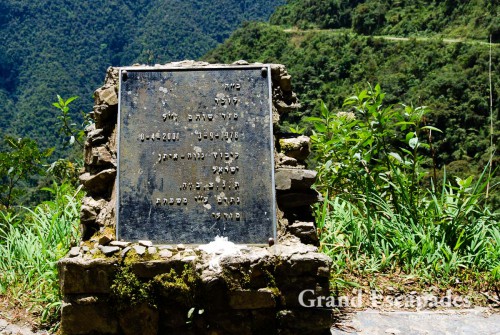
La Carratera de la Muerte or Death Road, going down from 4.650 meter to 1.250 Meter in only 64 Kilometer, between La Paz & Coroico, Bolivia
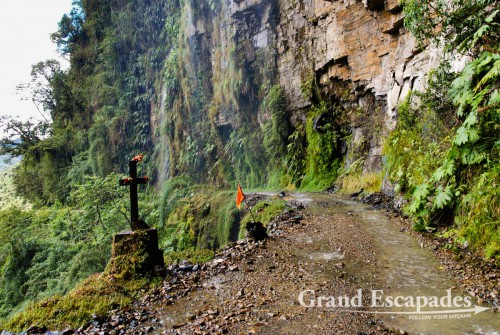
La Carratera de la Muerte or Death Road, going down from 4.650 meter to 1.250 Meter in only 64 Kilometer, between La Paz & Coroico, Bolivia
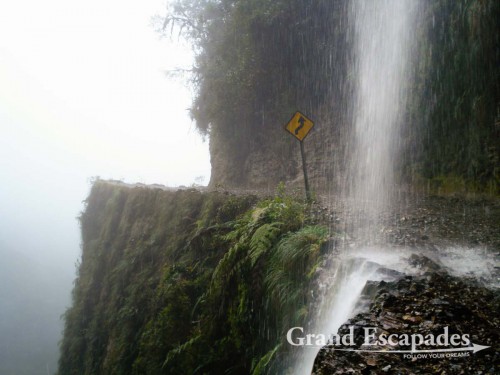
La Carratera de la Muerte or Death Road, going down from 4.650 meter to 1.250 Meter in only 64 Kilometer, between La Paz & Coroico, Bolivia
Knowing all this and given the dramatic title of this excursion, Heidi was very reluctant to do his trip. But since the new road was opened ten months ago, all traffic is of course using the latter. After visiting various companies we decided to go with Downhill Madness because they divide the group according to the speed people want to go. This was very important to us, since we did not want to be pressured by fast, daredevil bikers. Apart from that their equipment was state of the art and they have many years of experience, being the second company that started doing these trips.
What promised to be a scenic ride with a bit of adrenaline exceeded all our expectations!!! It was one of the most wonderful experiences for both of us, using only gravity to descend from 4.640 meters to 1.295 meters, within only 64 km.
When you start out at freezing La Cumbre, an hour from La Paz, the landscape is the typical barren Altiplano scenery with snow-capped mountains, 6.000 meters or higher, lurking from behind smaller mountains. We were lucky since it was not raining or snowing, which is often the case there. The first 30 km is a paved road with the steep slopes of the Altiplano gliding by. We were only a group of five and we all wanted to go slowly, which was perfect.
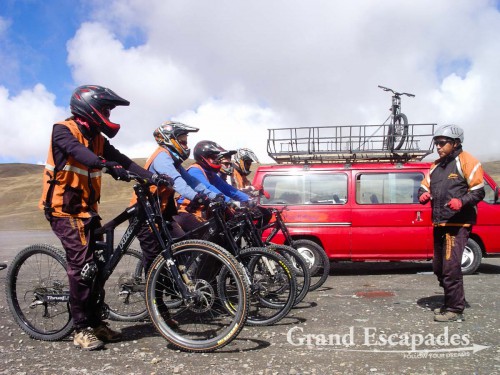
La Carratera de la Muerte or Death Road, going down from 4.650 meter to 1.250 Meter in only 64 Kilometer, between La Paz & Coroico, Bolivia
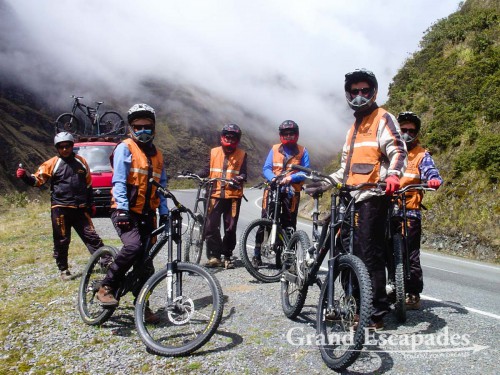
La Carratera de la Muerte or Death Road, going down from 4.650 meter to 1.250 Meter in only 64 Kilometer, between La Paz & Coroico, Bolivia
When the road started climbing for about 3km Heidi gave up after 30 seconds, pushing her bike and then even retreating into the support vehicle which follows every group of biker, so did the other three ladies. Gilles did not give in and only once used the car to hold on and pull him along a stepper bit.
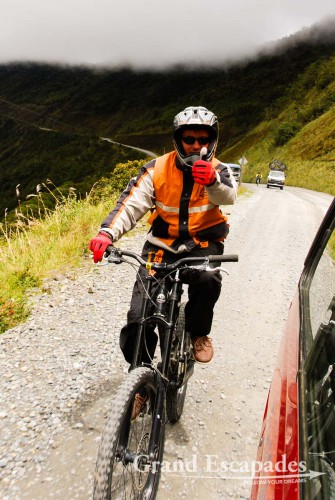
La Carratera de la Muerte or Death Road, going down from 4.650 meter to 1.250 Meter in only 64 Kilometer, between La Paz & Coroico, Bolivia
When the road leveled off we mounted our bikes again, soon we reached the part where the new road begins and the old road branches off following the mountain slope with the Coroico River deep below, like a silver band. Here the dirt road began, we were not immediately aware that this was already THE road, because it seemed more of a gravel path than anything else. It was only then that the expression “Death Road” did not seem all that cheesy!
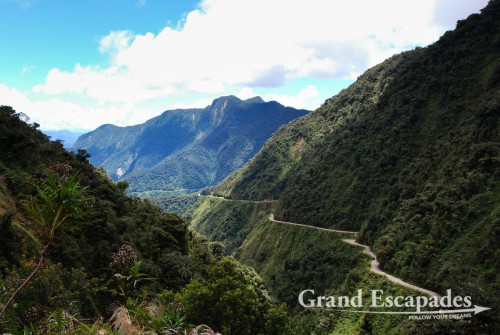
La Carratera de la Muerte or Death Road, going down from 4.650 meter to 1.250 Meter in only 64 Kilometer, between La Paz & Coroico, Bolivia
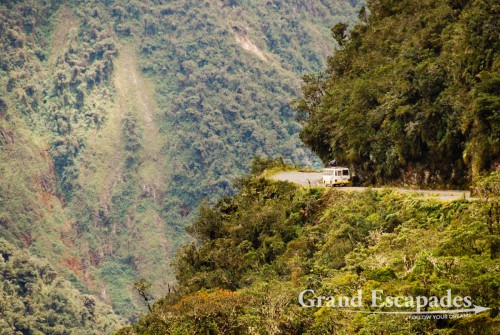
La Carratera de la Muerte or Death Road, going down from 4.650 meter to 1.250 Meter in only 64 Kilometer, between La Paz & Coroico, Bolivia
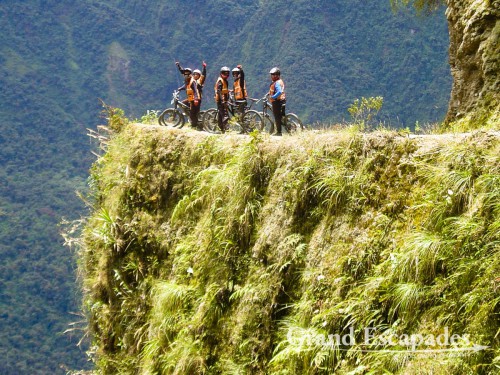
La Carratera de la Muerte or Death Road, going down from 4.650 meter to 1.250 Meter in only 64 Kilometer, between La Paz & Coroico, Bolivia
The landscape and the temperature changed quickly and the view became simply breathtaking. The green steep slopes of the Yungas region are full of lush vegetation and it became hard to concentrate on the road. Since we were such a small group we often stopped to take photos, have a snack and allow the driver to take photos and videos of us, these will be put on a CD, a fantastic souvenir. The longer we traveled the more confident we became. There was only one scary moment when one of the Australian ladies in our group went head on down onto the road because she had pulled the front brakes too abruptly. She went into the support car, but joined us later.
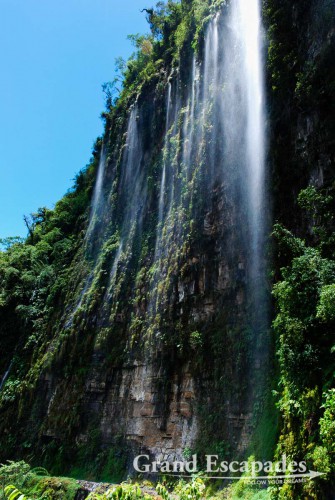
La Carratera de la Muerte or Death Road, going down from 4.650 meter to 1.250 Meter in only 64 Kilometer, between La Paz & Coroico, Bolivia
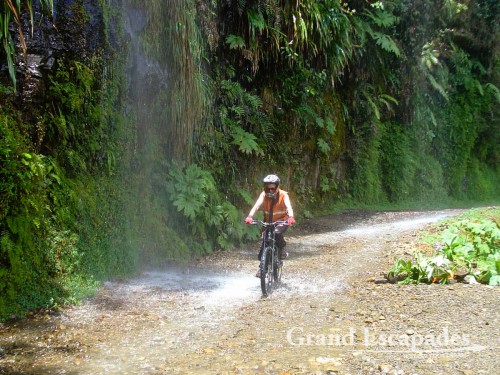
La Carratera de la Muerte or Death Road, going down from 4.650 meter to 1.250 Meter in only 64 Kilometer, between La Paz & Coroico, Bolivia
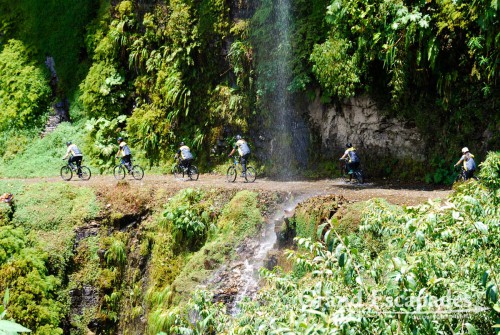
La Carratera de la Muerte or Death Road, going down from 4.650 meter to 1.250 Meter in only 64 Kilometer, between La Paz & Coroico, Bolivia
The closer we came to Coroico the more beautiful the landscape became, which made us decide to stay here for a couple of days. This trip always ends with a buffet lunch at the Hotel Esmeralda and a dip into its bright blue pool. This is what we have made our new home for the last two days …

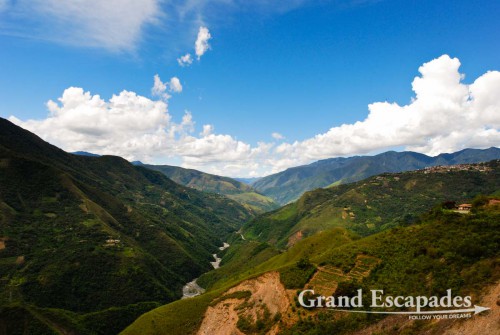
No comments yet.